Maine’s landfill is meant for in-state waste. Here’s how Massachusetts and NH are filling it up
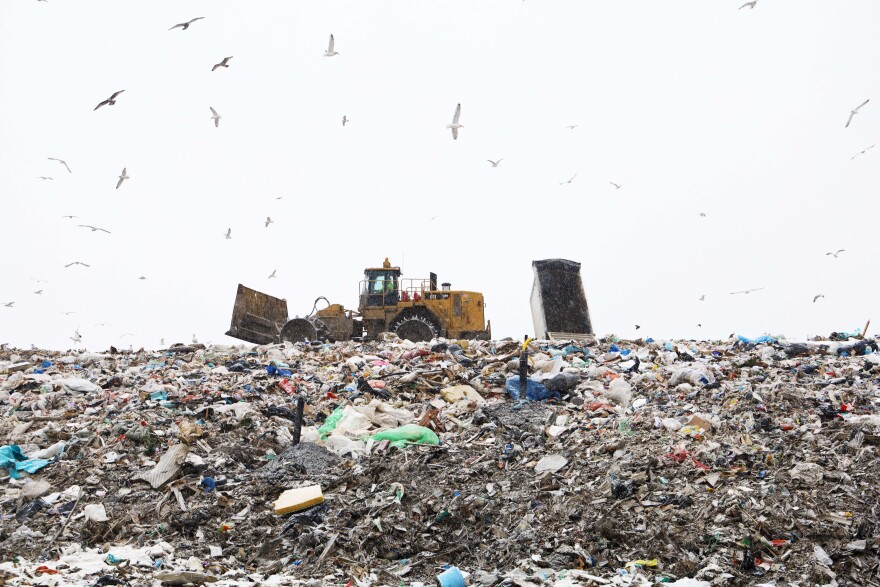
The state-owned Juniper Ridge Landfill in Old Town. (Esta Pratt-Kielley / Maine Public)
Every day, dozens of trucks loaded with waste drive through the gates of Juniper Ridge Landfill in Old Town.
Near the entrance, they’re greeted by a sign listing banned items, including refrigerators, propane tanks and dead animals. And at the bottom, in large red letters, is a warning: “Juniper Ridge Landfill only accepts waste generated in Maine.”
That rule — no waste from other states — has been a guiding principle of Maine’s trash laws since the late 1980s. It’s partly why the state even bought Juniper Ridge in 2004.
It’s also misleading: Other states have sent hundreds of thousands of tons of construction waste to the state dump over the years.
Massachusetts is the biggest exporter of all that wood, brick, asphalt and other debris, much of which is banned from its own landfills. The imports have accounted for almost a third of what’s buried in Maine’s state landfill in some years.
“Anything in there has to be ‘generated’ in Maine. Well, that’s kind of a trick word. It doesn’t mean all of this was thrown away for the first time in Maine,” says Ed Spencer, an Old Town resident who lives less than two miles from the dump. “The whole thing was a scam, and now it’s just grown and it’s become an established waste pathway.”
More than 60% of the licensed space at Juniper Ridge has now been used up, according to state records.
Along with the steady imports of construction debris, the landfill has received growing amounts of waste from within Maine, including construction materials, household garbage and sewage sludge. That has nearly doubled the speed at which it’s being filled in recent years, putting it on track for another expansion in six years.
Environmental activists, neighbors of the landfill including the Penobscot Nation and a growing group of lawmakers have decried the unique set of circumstances that allow private companies to dump so much material from Massachusetts into the state facility, despite laws that were once meant to prevent that.
“It’s really just filling up the Juniper Ridge Landfill,” says Peter Blair, a staff attorney at the Conservation Law Foundation. “It’s a huge amount of the available capacity, which is just increasing the need for future expansions and minimizing the amount of Maine-generated waste — true, Maine-generated waste — that can go there.”
Lots and lots of construction debris
Many different types of material are buried in Juniper Ridge, including ash from waste-to-energy incinerators, food scraps and other garbage that Mainers leave at the curb, and the sludge that communities remove from their wastewater.
By far, the most material comes from another source: construction and demolition sites around New England. That broad category now makes up about two-thirds of what’s buried in the state landfill each year — and it’s at the center of the critics’ concerns.
Some of that debris comes from inside Maine. The contractor that runs Juniper Ridge, Casella Waste Systems of Vermont, generally buries it in a raw form, without removing recyclable materials.
Those in-state deliveries have doubled in the last decade, topping 300,000 tons in 2020, according to data reported to the state Department of Environmental Protection.
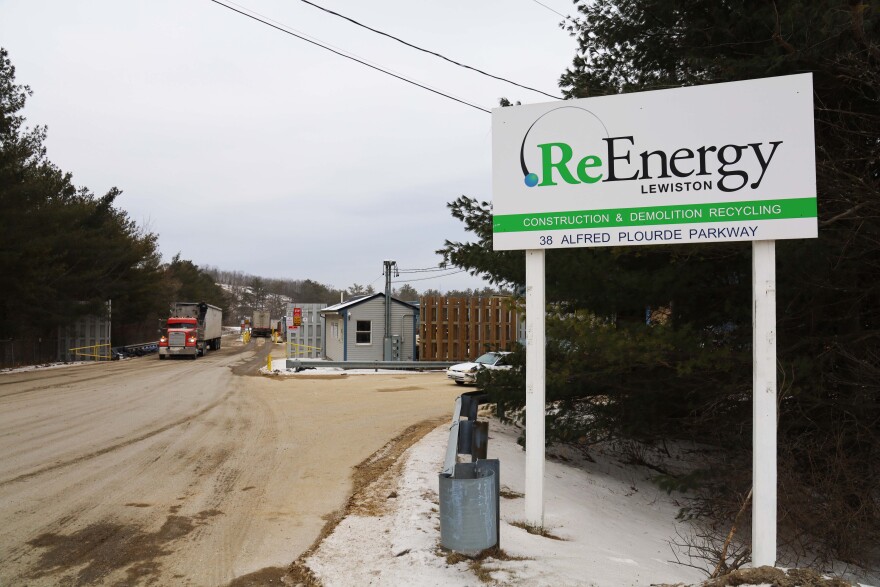
In Jan. 2022, a truck prepares to leave ReSource Lewiston, a facility that processes out-of-state before it’s sent to Juniper Ridge Landfill. The facility, which used to be called ReEnergy Lewiston, has not changed its sign. (Esta Pratt-Kielley / Maine Public)
More controversially, Casella has accepted consistently large amounts of construction waste from other states, primarily Massachusetts but also New Hampshire. They have totaled around 200,000 tons in some years — about the weight of two aircraft carriers.
The out-of-state material goes on a different type of journey before it can land in Juniper Ridge.
First, independent Maine truckers who have already delivered goods outside the state will stop by a transfer station, where they collect the debris. Then, they drive that material back to Maine and deliver it to a facility in Lewiston called ReSource.
ReSource Lewiston, which was a subsidiary of Casella until 2013 and still works closely with the landfill operator, removes a small amount of wood, metal, drywall or other material to sell for recycling.
It sorts the rest of the debris into two different piles: large bulky objects such as carpets and mattresses, and smaller materials that it has ground into a mulchlike mix. It then loads that sorted waste onto semi trucks heading another 120 miles up Interstate 95 and pays Casella to bury it at Juniper Ridge.
Before it’s buried, Casella says that the out-of-state debris has two primary uses.
The mulchlike mix is poured over raw trash each day to reduce its odor and prevent it from getting carried away by wind or animals. And bulky objects are mixed with incoming sewage sludge so that it forms a stable layer in the landfill.
A loophole for out-of-state waste
While Maine law only allows Juniper Ridge to accept waste “generated” within the state, a longstanding loophole has allowed the debris handled by ReSource to be considered Maine-generated.
With that new definition, ReSource has sent an average of about 190,000 tons of waste — roughly 90% of it from other states — to Juniper Ridge each year from 2011 to 2020, according to data it reports to the Maine Department of Environmental Protection.
For 15 years, Massachusetts has banned many types of construction debris from its own landfills, as part of a broader effort to reduce waste and preserve its own limited landfill space.
But in effect, the Bay State has shifted more of that burden onto other states including Maine. In the last decade, that loophole has allowed out-of-state companies to send more than a million tons of construction waste to Juniper Ridge by way of Lewiston, according to Maine DEP data.
Meanwhile, those who live in the shadow of Juniper Ridge resent that their community has become a dumping ground for so much waste from outside Maine.
“The imports mostly come from Massachusetts, which has basically strengthened its landfilling rules over the years,” Spencer says. “Maine needs to follow suit, or we’re just going — this is going to be full.”
Spencer, who started building his home in West Old Town in the late 1970s, has grown familiar with the nuisances that come from living near a dump.
He has made a living logging the surrounding forest, but there’s one section of quaking aspen that he hasn’t bothered to cut, since it hides the rolling hills of refuse that have risen beyond his property since the state bought Juniper Ridge in 2004.
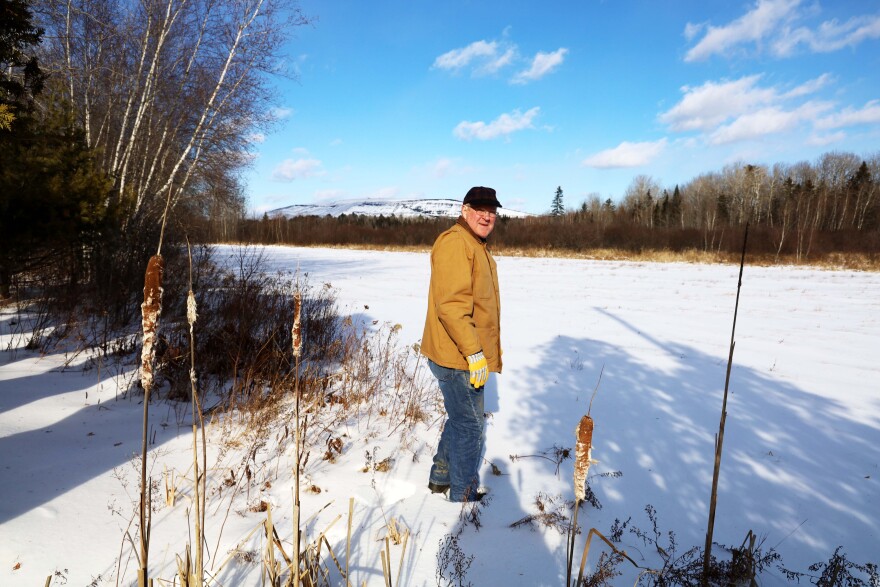
Ed Spencer, a West Old Town resident whose home is less than two miles from Juniper Ridge, looks at the dump from one part of town. (Esta Pratt-Kielley / Maine Public)
Still, that barrier has not stopped the rotting odor of sewage or garbage from reaching his home from time to time. On a handful of occasions, he says, “It makes you feel like you can’t breathe.”
Concerns about pollution
Members of the Penobscot Nation have also spoken out against the imported waste buried at Juniper Ridge, which is about four miles from their reservation on Indian Island. On Earth Day last year, they helped organize a caravan outside the landfill to protest the imports.
“There is enough garbage that we need to take care of here,” says Kathy Paul, a longtime tribal activist who was born and raised on Indian Island. “Why are they taking someone else’s?”
Although the majority of the landfill’s waste originates inside the state, tribal members fear the imported debris is increasing pollution in the liquid, or leachate, that seeps out of the landfill over time — in particular, a widely used group of chemicals known as PFAS.
“The stuff we see coming in, this oversized bulky waste, construction and demolition debris, we know it’s loaded with some classes of chemicals that we’re concerned with, particularly PFAS,” says Dan Kusnierz, the tribe’s water resources program manager. “Things like carpets, couches, upholstery, textiles, a lot of that type of material has been treated with PFAS-containing compounds.”
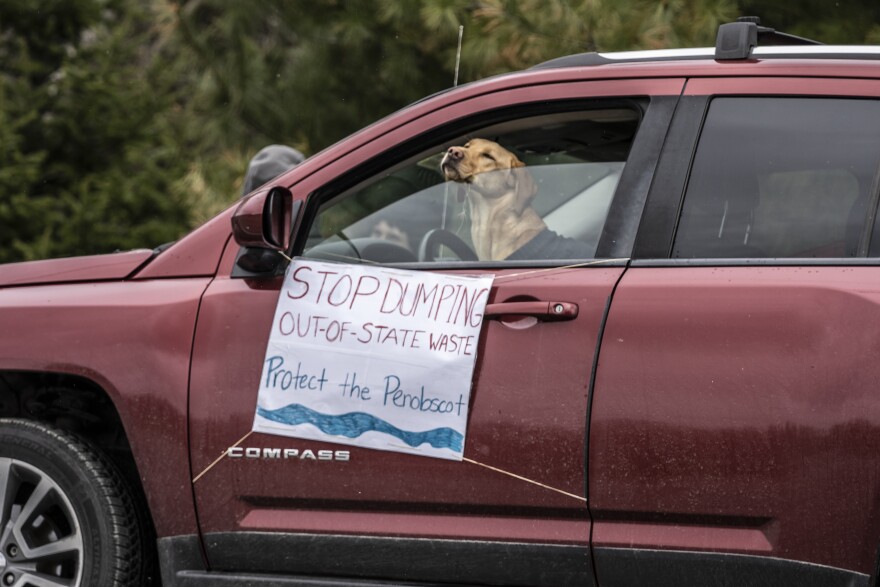
A protest outside Juniper Ridge Landfill in Old Town on April 22, 2021. (Nick Woodward / Maine Public)
No studies have drawn a link between the landfill’s leachate — or the subset of its waste from other states — and contamination of the surrounding environment.
But as part of the state’s ramped up monitoring for PFAS in the last couple years, it has found PFAS in the Juniper Ridge leachate at levels much higher than the state drinking water standard — a standard that landfill leachate doesn’t need to meet.
Under its state license, Casella collects the leachate and sends it to a pulp mill on the other side of Old Town, where it’s treated and discharged into the Penobscot River just downstream from Indian Island. But state regulators have acknowledged that no wastewater facilities in Maine have the technology to fully remove PFAS, which are linked to cancer and other health threats.
That concerns tribal members, who have traditionally relied on the Penobscot River for fishing and other sustenance activities, as well as for their cultural identity.
Harmful contaminants including dioxins, mercury and PCBs have been detected in fish in the river, prompting state advisories for people to either avoid or limit their consumption. Recent research has also identified some PFAS contamination in striped bass and other fish that migrate into tribal waters.
A more general concern for the tribe is where the next state landfill might open if Juniper Ridge eventually runs out of space. The state owns two other inactive landfill sites that could be candidates. Like Juniper Ridge, both are near the tribe’s namesake river.
“It’s a little strange that the three state-owned landfills are all in the Penobscot watershed,” Kusnierz says. “It’s certainly a disproportionate impact on a community.”
Unintended consequences
One of the bedrock goals of Maine’s waste policies is to limit the ability of other states to dump their trash here.
When lawmakers first passed those laws in 1989, they were reluctant to enact an outright ban on waste imports, given legal precedents that allow companies to carry trash across state lines. Instead, they found a workaround: new commercial landfills were banned, and any future landfills would be developed by the state to ensure they had enough room for Maine’s own waste.
So, how has so much room in Maine’s state landfill been used up by another state?
State lawmakers and environmental officials have been asking that question for more than a decade. A Blue Ribbon Commission examined the imports in 2007, and the Legislature’s watchdog committee considered investigating them a few years later.
The answer is partly Massachusetts’ ban on landfilling construction materials, which created more pressure for that waste to come to Maine.
But that’s not the full story. Casella has also been a willing partner to the companies producing that waste. It charges customers “tipping fees” for every ton of waste buried in the state landfill and has worked closely with other businesses to bring the out-of-state material to Juniper Ridge.
And in Augusta, state officials have made some key decisions that inadvertently allowed those imports to reach Juniper Ridge.
One of those decisions came with the first waste law overhaul in 1989. While lawmakers thought that it would be easier to ban imported waste from a state-owned landfill, they didn’t immediately follow through with clear rules doing so.
A more fateful decision came in 2004, when the state finally bought Juniper Ridge and awarded Casella a contract to run it for 30 years, after the Vermont company provided $26 million for the purchase.
Under its operating agreement, the administration of former Gov. John Baldacci explicitly allowed Casella to bury some out-of-state construction debris there.
At the time, the sole contractual purpose of the exemption was for Casella to remove wood chips that would be burned as biomass fuel at the pulp mill on the other side of Old Town. The remainder would be buried at Juniper Ridge.
The initiative was one attempt to bail out the mill after it laid off 300 workers in the previous year. But it fell apart just a few years later, with state data showing the mill only burned a total of 55,000 tons of the fuel between 2006 and 2008. Casella didn’t stop burying out-of-state construction waste at Juniper Ridge, however.
In fact, after another Casella-owned landfill closed in the town of Hampden in 2009, it began sending even more debris, most of it from other states, to the state landfill through its Lewiston facility.
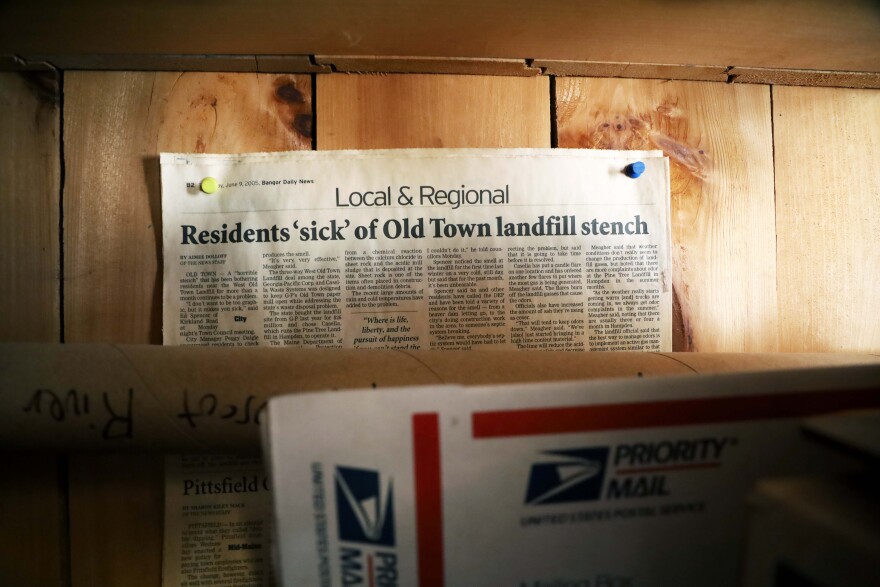
A clipping from a 2005 article in the Bangor Daily News that hangs in the home of Ed Spencer, a West Old Town resident who has opposed the out-of-state waste ending up at Juniper Ridge. (Esta Pratt-Kielley / Maine Public)
Those deliveries more than tripled over four years, from 61,000 tons in 2008 to 222,000 tons in 2011, according to Maine DEP data. They dipped over the next few years, but the most recent data show they bounced back to 220,000 tons in 2019 and 182,000 in 2020.
‘A recycling facility that isn’t doing much recycling’
Some officials cried foul when it became clear how little biomass fuel Casella was actually removing from the out-of-state waste.
In a letter opposing a proposed expansion of the landfill in 2011, Bob Duchesne, who at the time was state representative for a cluster of towns near Juniper Ridge, accused the contractor of inflating its projected needs given all the imported waste “funneled” through the Lewiston facility under the guise of recycling.
“A substantial amount of waste landfilled at Juniper Ridge in 2010 — over a quarter of the total — came from a recycling facility that isn’t doing much recycling,” Duchesne wrote.
The “apparent role” of the Lewiston facility, he added, is “not to produce biofuels. It is to convert out-of-state waste to in-state waste for purposes of disposal at Juniper Ridge.”
While state environmental regulators have also expressed concern about the explosion of imports, they’ve only taken indirect steps to restrict them over the years, such as capping how much bulky waste Juniper Ridge can accept and proposing a stricter recycling standard for facilities such as ReSource Lewiston.
They have called on the state agency that owns the landfill, now the Department of Administrative and Financial Services, to try to change the “outdated” section of Casella’s contract allowing the imports — a change that still hasn’t come.
Periodically, the Legislature has considered proposals to restrict those imports since at least 2007, when it finally banned waste “generated” outside Maine from state landfills. But it has shied away from doing so amid lobbying from Casella and its partners.
Meanwhile, environmental advocates have lost patience with the lack of any serious reform. They accuse Casella of flouting Maine’s recycling policies to protect its bottom line.
“It’s clear there is a special business arrangement between Casella and ReSource where they rely on each other to make money,” Sarah Nichols, a waste policy director for the Natural Resources Council of Maine, told lawmakers in January. “These companies are relying on the state to continue expanding the landfill to support their business model, and we can’t allow this to happen.”
Loophole or lifeline?
Casella and ReSource have declined to share details of their business agreements, but both appear to have deep pockets.
Casella, a growing Northeastern waste empire that stretches from here to Pennsylvania, saw its annual revenues hit $889 million last year, up more than $100 million from the year before. The New York-based parent company of ReSource recently announced that a private equity firm worth $70 billion had become the majority owner of its waste division.
Now, Casella’s case for why it needs the out-of-state waste mainly boils down to money.
It argues those imports are the most affordable source of two materials needed to run the state dump: daily cover, and bulky materials that allow wastewater sludge to be buried. In recent years, it has pointed to the growing volumes of sludge getting sent to the landfill — due to concerns that it could be carrying PFAS — as further justification for the imports.
“It’s not a loophole as much as it’s a lifeline,” Shelby Wright, Casella’s eastern region manager of engagement, said during an interview. “We have needed a consistent source of oversized bulky waste to bulk these items up for safe disposal.”
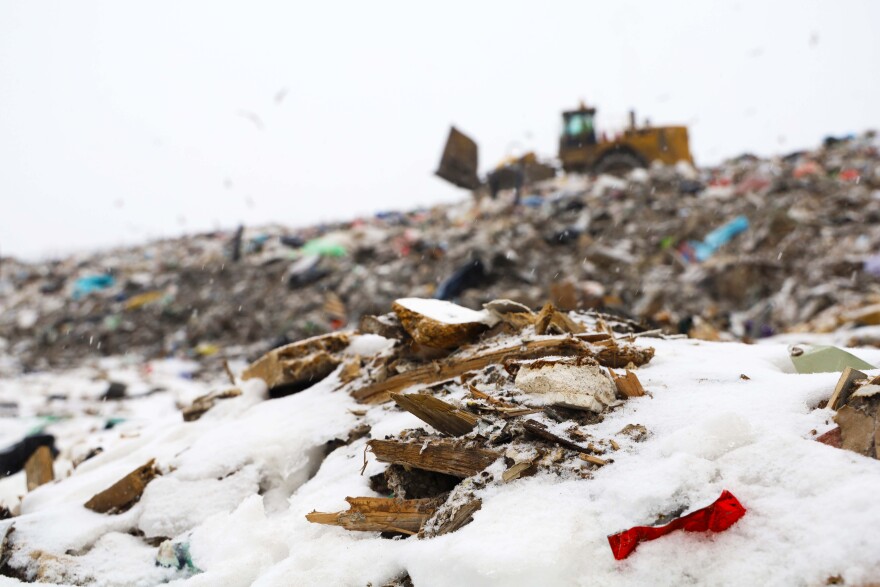
Construction and demolition debris that’s been deposited in an active section of Juniper Ridge Landfill. (Esta Pratt-Kielley / Maine Public)
There are alternatives to the finely ground construction debris that Casella uses as daily cover, such as soil, reusable tarps and foams.
Similarly, Maine has an abundance of its own construction debris that could, in theory, replace the out-of-state waste that’s imported to ReSource Lewiston. Right now, in-state debris is generally buried at Juniper Ridge and other landfills without any attempt to remove items to be sold for recycling.
But switching to those options could force Casella and its business partners to pay more for transportation and materials while sacrificing the easy revenue they get from carrying big loads of construction waste out of Massachusetts and New Hampshire.
Casella warns that any new restrictions could drive up landfilling prices at Juniper Ridge. ReSource, which has recently been updating its recycling infrastructure, says they could jeopardize jobs at its Lewiston plant.
Both companies note that there are no facilities in northern or eastern Maine that process construction debris, making it cheaper for contractors in many parts of the state to send their waste straight to the closest landfill, rather than hiring a trucker to carry it on the long trip south to ReSource.
“Without a mandate that says we need to recycle X amount of construction and demolition debris, there is no incentivization to do that economically for most people,” Wright told lawmakers in January.
More momentum for change
Now that Juniper Ridge is filling up at twice the rate it was a couple years ago, Maine lawmakers seem more open to restricting the companies that have been bringing in Massachusetts and New Hampshire waste.
In February, a bipartisan group from the Legislature’s natural resources committee recommended passage of a bill from Democratic Sen. Anne Carney of Cape Elizabeth that would attempt to close the out-of-state waste loophole in a few ways.
The bill, LD 1639, would limit how much waste a facility such as ReSource can classify as Maine-generated — and thus, send along to Juniper Ridge — to whatever amount it has accepted from within Maine each year.
It would also phase out an exemption that ReSource has received from Maine’s recycling rules, add “environmental justice” as a standard for future waste facilities to meet and force the state to review its contract with Casella.
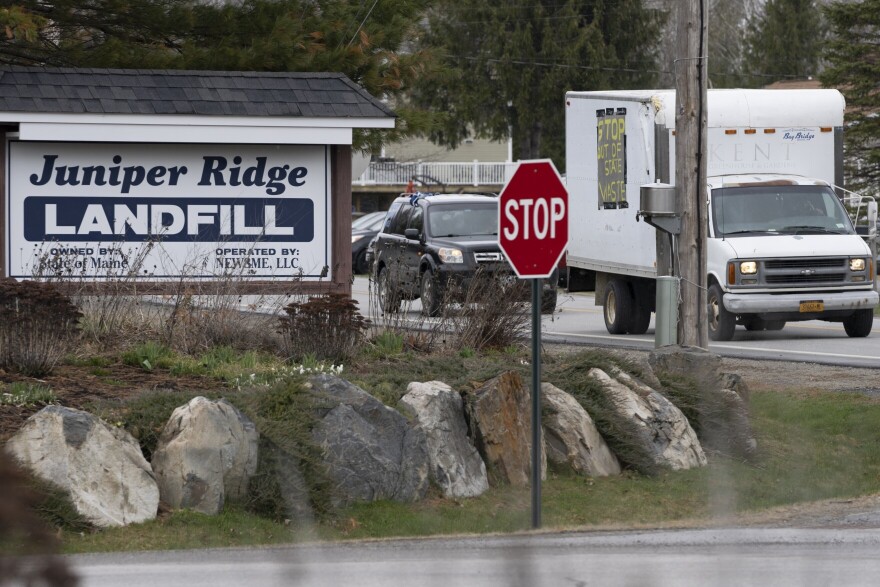
Protesters outside Juniper Ridge Landfill in Old Town on April 22, 2021. (Nick Woodward / Maine Public)
Before the vote, Carney suggested that the bill would be a “win-win,” slowing the depletion of Juniper Ridge while pushing ReSource to recycle more of Maine’s own construction debris.
It’s hard to predict the ultimate fate of the bill, in part because two Republican lawmakers have recently proposed an amendment that would water it down.
But the current Legislature has already passed one big piece of waste reform that was opposed by industry groups: a first-in-the-nation law requiring companies to pay for the disposal of their packaging.
Sen. Rick Bennett, a Republican from Oxford County who supports Carney’s bill, compared the waste imports to the $1 billion transmission line that Central Maine Power is trying to build through western Maine to send Canadian hydropower to Massachusetts, but which Maine voters rejected last fall.
Both are examples of “powerful entities perhaps abusing Mainers’ naivete and our resources,” Bennett said. “We need to be more sophisticated. We need to think carefully about what our own needs are, and what’s best for our environment, and what’s best for our way of life.”
If Maine does restrict the imports, it’s possible that Massachusetts companies would just find another outlet for their construction waste. That could include Maine’s second-largest dump, the privately owned Crossroads Landfill in Norridgewock, which can’t be restricted in the same way as Juniper Ridge, or other facilities along the East Coast.
Blair, from the Conservation Law Foundation, suggested that other states could come up with their own regulations on imported waste.
That way, he says, Massachusetts might have no choice but to reduce how much trash it’s sending over its borders.
Maine Public’s Esta Pratt-Kielley and Andrew Catalina contributed reporting. WBUR’s senior investigations editor-reporter, Christine Willmsen, provided editing assistance.
Click here to listen to an interview about this story with Maine Public’s Charlie Eichacker.
Visit this page for more NENC stories on trash and waste issues in New England.
